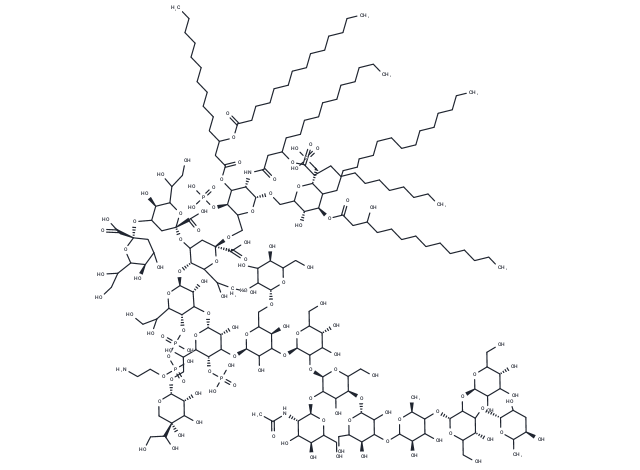 Your shopping cart is currently empty
Your shopping cart is currently empty

Lipopolysaccharides (LPS), derived from Escherichia coli O55:B5, are essential components of the outer membrane of Gram-negative bacteria. Composed of lipid A, a core oligosaccharide, and an O-specific polysaccharide, LPS exhibits strong immunogenicity. It activates immune cells via the TLR4 receptor, induces chemotactic cell migration and cytokine secretion, and helps maintain the integrity of the bacterial outer membrane, protecting against bile salts and lipid-based antibiotics. LPS is commonly used to establish inflammatory models, including arthritis, chronic obstructive pulmonary disease (COPD), acute respiratory distress syndrome (ARDS), and gastrointestinal disease models.

| Pack Size | Price | USA Warehouse | Global Warehouse | Quantity |
|---|---|---|---|---|
| 1 mg | $45 | In Stock | In Stock | |
| 5 mg | $107 | In Stock | In Stock | |
| 10 mg | $178 | In Stock | In Stock | |
| 25 mg | $397 | In Stock | In Stock | |
| 50 mg | $672 | In Stock | In Stock |
| Description | Lipopolysaccharides (LPS), derived from Escherichia coli O55:B5, are essential components of the outer membrane of Gram-negative bacteria. Composed of lipid A, a core oligosaccharide, and an O-specific polysaccharide, LPS exhibits strong immunogenicity. It activates immune cells via the TLR4 receptor, induces chemotactic cell migration and cytokine secretion, and helps maintain the integrity of the bacterial outer membrane, protecting against bile salts and lipid-based antibiotics. LPS is commonly used to establish inflammatory models, including arthritis, chronic obstructive pulmonary disease (COPD), acute respiratory distress syndrome (ARDS), and gastrointestinal disease models. |
| Targets&IC50 | bovine aortic endothelial cell proliferation:22 ng/mL, SH-SY5Y cells viability:0.25 μg/mL (48h), A549 cells viability:11.06 mg/L |
| In vitro | METHODS: Human lung mucoepidermoid carcinoma cells H292 and monocytes THP-1 were treated with Lipopolysaccharides (1-20 µg/mL) for 6-48 h. Cytotoxicity was detected by MTT.
RESULTS: No significant changes in the viability of H292 cells treated with 1 and 2.5 µg/mL Lipopolysaccharides and THP-1 cells treated with 1 and 2 µg/mL Lipopolysaccharides were observed. Lipopolysaccharides at higher concentrations (5-20 µg/mL) were significantly cytotoxic to both H292 and THP-1 cells. [1] METHODS: Human induced pluripotent stem cell-derived cardiomyocytes hiPSC-CMs were treated with Lipopolysaccharides (0.1-100 µg/mL) for 6-48 h. Inflammatory cytokine expression was detected by qRT-PCR. RESULTS: The mRNA expression level of IL-1β was increased at 6 h of Lipopolysaccharides treatment, IL-10 was increased only at 48 h, and TNF-α and IL-6 were increased at both 6 and 48 h. [2] METHODS: Neutrophils were treated with Lipopolysaccharides (10 mg/ml) for 4 h. The expression levels of target proteins were measured by Western Blot. RESULTS: The expression of H3-cit and TLR4 increased after treatment with Lipopolysaccharides, which induced the formation of neutrophil extracellular traps (NETs) in neutrophils. [3] |
| In vivo | METHODS: To construct a mouse model of sepsis, Lipopolysaccharides (25 mg/kg) were administered to C57/BL mice by a single intraperitoneal injection.
RESULTS: Lipopolysaccharides induced significant up-regulation of inflammatory factors TNF-α and IL-1β. Lipopolysaccharides induced sepsis in a mouse model. [4] METHODS: To investigate the effects of Lipopolysaccharides on cognitive deficits and neuroinflammation, Lipopolysaccharides (500-750 μg/kg in saline) were injected intraperitoneally into C57BL/6J mice once daily for seven days. RESULTS: Lipopolysaccharides treatment resulted in disease behavior and cognitive deficits in mice, and these effects were accompanied by microglia activation and neuronal cell loss in the hippocampus. Lipopolysaccharides treatment decreased serum and brain homogenate levels of IL-4 and IL-10, and increased levels of TNF-α, IL-1β, PGE2, and NO levels were increased. [5] |
| Synonyms | LPS |
| Molecular Weight | 4899.92 |
| Formula | C205H366N3O117P5 |
| Smiles | CCCCCCCCCCCCCCCC1[C@H](OC([C@H]([C@@H]1OC(=O)CC(CCCCCCCCCCC)O)O)CO[C@H]2[C@H](C([C@@H](C(O2)CO[C@@]3(CC([C@H](C(O3)C(CO)O)O[C@H]4[C@@H](C([C@@H](C(O4)C(CO)O)OP(=O)(O)OP(=O)(O)OCCN)O[C@@H]5[C@@H](C([C@@H](C(O5)C(CO[C@@H]6[C@@H](C([C@](CO6)(C(CO)O)O)O)O)O)OP(=O)(O)O)O[C@@H]7C(C([C@@H](C(O7)CO[C@@H]8C(C([C@H](C(O8)CO)O)O)O)O)O[C@@H]9C(C([C@H](C(O9)CO)O)O)O[C@@H]1C(C([C@@H](C(O1)CO)O[C@@H]1C(C([C@H](C(O1)CO)O)OC1[C@@H](C(C([C@@H](O1)C)O[C@@H]1C(C([C@@H](C(O1)CO)O)O[C@@H]1C(C[C@H](C(O1)C)O)O)O[C@@H]1C(C([C@H](C(O1)CO)O)O)O)O)O)O)O)O[C@@H]1[C@H](C([C@@H](C(O1)CO)O)O)NC(=O)C)O)O)O)O[C@@]1(CC([C@H](C(O1)C(CO)O)O)O[C@@]1(CC([C@H](C(O1)C(CO)O)O)O)C(=O)O)C(=O)O)C(=O)O)OP(=O)(O)O)OC(=O)CC(CCCCCCCCCCC)OC(=O)CCCCCCCCCCCCC)NC(=O)CC(CCCCCCCCCCC)OC(=O)CCCCCCCCCCC)CP(=O)(O)O |
| Relative Density. | no data available |
| Storage | Powder: -20°C for 3 years | In solvent: -80°C for 1 year |
| Solubility Information | H2O: 5 mg/mL (1.02 mM), Sonication is recommended. DMSO: 1 mg/mL (0.2 mM), Sonication is recommended. DMSO may influence Lipopolysaccharides activity. |
| Size | Quantity | Unit Price | Amount | Operation |
|---|

Copyright © 2015-2026 TargetMol Chemicals Inc. All Rights Reserved.